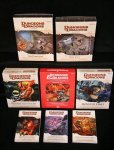Tony Vargas
Legend
I did not find optimization a huge problem in 4e, in general, since it wasn't as execrably balanced as other editions. I have had some crazy optimizers in my games, of course, but the impact just wasn't as shattering as in 3.x - besides, to my mind 'optimization' can be an exercise in tailoring a build to concept, as much to tailoring for DPR or whatever.I won't disagree that, used with the spirit in which they were created, Themes could be very helpful to a player in adding just that extra bit of 'oomph' to a character background. The problem was that, in practice, most folks playing (in our area, anyway) tended to use themes as an additional layer of character optimization.
Edit: to be clear, I often did find optimization to be a huge deal, in 4e, there was plenty of it to do,
if you were so inclined, plenty of players enthusiastically so inclined, and there were rewards to be eked out with sufficient system mastery. It just never dominated the whole experience 3.x/PF-style.
Well, that'd be broken as all get-out, of course, since Extra Attack is such a wildly powerful feature in 5e.As a hypothetical, say there was a 5e Background (let's call it 'Nemesis') that allowed you to choose a type of opponent, and gave you an extra attack
It would be like giving out a 5th level wizard daily in the Wizard's Apprentice Theme. Obviously nuts. No theme did anything like that. OTOH, more literally, an 'extra attack' theme power in 4e that was an encounter and made two attacks, each against a different target, probably fine.
But it would be nice if 5e Backgrounds had features that could kick in at higher levels, it'd keep 'em more relevant & interesting.
They include weapon proficiencies and spells, so, not that tightly focused, but, yeah, as far as they go. Classes also (most of 'em) have plenty of non-combat-related stuff in 5e. There's really not a lot of consistency to it.That the granted abilities of 5E backgrounds are restricted to non-combat and RP-related effects, as appropriate for a feature that's meant to flesh out those parts of the game
5e design was primarily about re-instating flaws! ;P And, popularity, of course., is a sign that the 5E designers noted the flaws in theme design in 4E and decided not to include that aspect in the new design.
They were certainly popular, but popular does not automatically mean positive.
Last edited:




